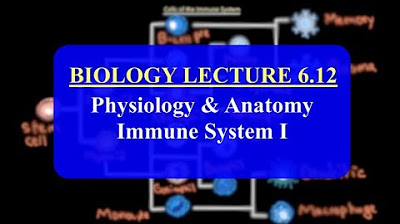Hoe versla jij elke dag zeven infecties en tien tumoren? (1/5)
Summary
TLDRThis video explores the complexities of the human immune system, highlighting its critical role in defending the body against infections and diseases. From the skin's initial defense to the intricate immune responses that target viruses, bacteria, and even tumor cells, the script emphasizes how our immune system distinguishes between harmful and harmless agents. The video also touches on the fascinating balance between the immune system and the body’s own cells, how the system learns to protect us from pathogens, and the importance of immune memory in maintaining health. Ultimately, the video underscores the significance of the immune system in overall health and its essential role in disease prevention.
Takeaways
- 😀 The human body is constantly under attack from pathogens, including viruses, bacteria, and parasites, and the immune system plays a crucial role in defending against these threats.
- 😀 The immune system, though often unseen, is an essential organ, weighing about 1.5 kg, similar to the brain or liver, and is crucial for health.
- 😀 70% of immune cells are located in the gut, making it the most significant area for immune defense against invaders.
- 😀 Recent research challenges the long-held belief that there are 10 times as many bacteria in the body as human cells, suggesting a ratio closer to 3:1.
- 😀 The immune system must differentiate between harmful pathogens and harmless substances in the body, a process known as immune tolerance.
- 😀 From conception, the fetus is seen as foreign by the mother's immune system, but the placenta helps prevent rejection, and the fetus's immune defense develops over time.
- 😀 At birth, a baby’s sterile gut is exposed to beneficial bacteria from the mother, which helps train the infant's immune system to distinguish between harmful and harmless substances.
- 😀 The immune system’s innate defense system reacts quickly but broadly, while the adaptive immune system provides more specific and targeted responses over time.
- 😀 Mutations in our own cells, such as those causing tumors, are a regular occurrence in the body, with an average of 50 to 100 tumor mutations occurring daily.
- 😀 Natural killer (NK) cells are vital for destroying tumor cells and infected cells in the bloodstream, acting as the first line of defense in immune responses.
Q & A
What is the primary focus of the immune system in protecting the body?
-The immune system's primary focus is to defend the body against various pathogens such as viruses, bacteria, and parasites. It works by quickly recognizing and responding to these foreign invaders, either by direct destruction or by signaling other parts of the immune system to act.
How does the body deal with pathogens like bacteria or viruses?
-The immune system detects pathogens and launches a rapid defense, typically within 2-3 minutes of their entry into the body. This includes mechanisms such as inflammation, immune cell activation, and the targeted destruction of the harmful agents.
Why is the gut considered a major battleground for the immune system?
-The gut contains around 70% of the body’s immune cells and is exposed to a large number of bacteria and other microorganisms. The gut's immune system plays a critical role in protecting against infections and maintaining the balance between harmful and beneficial bacteria.
What role does the immune system play in recognizing harmless substances?
-The immune system must differentiate between harmful pathogens and harmless substances like food. This ability to distinguish between ‘self’ and ‘non-self’ is called tolerance, and it helps prevent unnecessary immune responses against non-threatening substances.
What is the process through which the immune system learns tolerance?
-Tolerance begins during fetal development when the immune system learns to recognize the fetus as ‘self’ despite half of its genetic material being foreign. After birth, the immune system continues to refine its ability to recognize harmless substances, aided by the microbiota transferred from the mother.
How does the immune system protect against tumors?
-The immune system detects and destroys tumor cells through specialized cells like Natural Killer (NK) cells, which can identify and eliminate tumor cells that have mutated or are growing uncontrollably.
What is the difference between innate and adaptive immunity?
-Innate immunity is the first line of defense, providing quick, but less specific protection. It reacts within minutes to pathogens and other threats. Adaptive immunity, on the other hand, is slower but more precise, targeting specific pathogens and building long-term immunity after an infection.
What is the role of inflammation in the immune response?
-Inflammation is a key part of the immune response, marking the body’s reaction to injury or infection. Acute inflammation is beneficial as it helps the body fight off infections and heal wounds. However, chronic inflammation can be harmful and lead to tissue damage.
What can happen if inflammation becomes chronic?
-Chronic inflammation can lead to tissue damage, contributing to a variety of health problems, including autoimmune diseases and cancer. It’s important for inflammation to resolve after it serves its protective role.
How does the immune system's memory function in fighting infections?
-The adaptive immune system has memory, meaning that once it has encountered a pathogen, it can recognize and respond more quickly and effectively if the same pathogen invades again. This is the basis of immunity and vaccination.
Outlines

此内容仅限付费用户访问。 请升级后访问。
立即升级Mindmap

此内容仅限付费用户访问。 请升级后访问。
立即升级Keywords

此内容仅限付费用户访问。 请升级后访问。
立即升级Highlights

此内容仅限付费用户访问。 请升级后访问。
立即升级Transcripts

此内容仅限付费用户访问。 请升级后访问。
立即升级浏览更多相关视频

Sistema Imunológico e Imunidade Inata | Anatomia etc

IMAT Biology Lesson 6.12 | Anatomy and Physiology | Immune System Part I

Understanding White Blood Cells and Their Role in the Immune System (5 Minutes)

Bab. sistem imun - sistem kekebalan tubuh . pelajaran biologi sma kelas 11 fungsi sistem imun

How immunotherapy could help us beat cancer | Deepta Bhattacharya | TEDxUArizona

Konsep umum : Dasar sistem imun, sistem pertahanan tubuh, imunologi
5.0 / 5 (0 votes)
